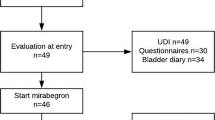Abstract
Introduction and hypothesis
The aim of the study was to assess the sensory and motor effects of antimuscarinic treatment on the bladder in women with overactive bladder, detrusor overactivity demonstrated on urodynamics and a mean bladder wall thickness (BWT) greater than 5 mm.
Methods
Fifty-eight women underwent treatment with antimuscarinics in 12 weeks. Before treatment and at 1, 2, 6 and 12 weeks of treatment, women completed the patient perception of bladder condition (PPBC) single-item global questionnaire, indicated the severity of their urgency on a visual analogue scale (VAS) and underwent transvaginal ultrasound to determine mean bladder wall thickness (BWT).
Results
PPBC and VAS scores for urgency declined throughout the treatment course whereas mean BWT declined during the first 6 weeks of treatment and then reached a plateau after falling to below 5 mm.
Conclusion
The mechanism of action of antimuscarinics appears to be a complex interaction of sensory and motor components.




Similar content being viewed by others
References
Abrams P, Cardozo L, Fall M, Griffiths D, Rosier P, Ulmsten U, van KP, Victor A, Wein A (2002) The standardisation of terminology of lower urinary tract function: report from the Standardisation Sub-committee of the International Continence Society. Am J Obstet Gynecol 187:116–126
Digesu GA, Khullar V, Cardozo L, Salvatore S (2003) Overactive bladder symptoms: do we need urodynamics? Neurourol Urodyn 22:105–108
Brading AF (1997) A myogenic basis for the overactive bladder. Urology 50:57–67
Oliver S, Fowler C, Mundy A, Craggs M (2003) Measuring the sensations of urge and bladder filling during cystometry in urge incontinence and the effects of neuromodulation. Neurourol Urodyn 22:7–16
Silva C, Silva J, Castro H, Reis F, Dinis P, Avelino A, Cruz F (2007) Bladder sensory desensitization decreases urinary urgency. BMC Urol 7:9
Abrams P, Cardozo L, Chapple C, Serdarevic D, Hargreaves K, Khullar V (2006) Comparison of the efficacy, safety, and tolerability of propiverine and oxybutynin for the treatment of overactive bladder syndrome. Int J Urol 13:692–698
Finney SM, Andersson KE, Gillespie JI, Stewart LH (2006) Antimuscarinic drugs in detrusor overactivity and the overactive bladder syndrome: motor or sensory actions? BJU Int 98:503–507
Yamaguchi O (2010) Antimuscarinics and overactive bladder: other mechanism of action. Neurourol Urodyn 29(1):112–115
Khullar V, Salvatore S, Cardozo L, Bourne TH, Abbott D, Kelleher C (1994) A novel technique for measuring bladder wall thickness in women using transvaginal ultrasound. Ultrasound Obstet Gynecol 4:220–223
Khullar V, Cardozo LD, Salvatore S, Hill S (1996) Ultrasound: a noninvasive screening test for detrusor instability. Br J Obstet Gynaecol 103:904–908
Coyne KS, Matza LS, Kopp Z, Abrams P (2006) The validation of the patient perception of bladder condition (PPBC): a single-item global measure for patients with overactive bladder. Eur Urol 49:1079–1086
Finney SM, Stewart LH, Gillespie JI (2007) Cholinergic activation of phasic activity in the isolated bladder: possible evidence for M3- and M2-dependent components of a motor/sensory system. BJU Int 100:668–678
Acknowledgments
We would like to express our gratitude for the support provided by the NIHR Biomedical Research Centre funding scheme.
Conflicts of interest
D. C. Panayi: funded by Pfizer for travel and accommodation -- International Continence Society Cairo 2008. V. Khullar: paid consultant to Astellas, Lilly, Allergan, Pfizer, Gynecare, Cook, Bioxell. R. Fernando: paid consultant to Astellas, Pfizer. P. Tekkis: no disclosures.
Author information
Authors and Affiliations
Corresponding author
Rights and permissions
About this article
Cite this article
Panayi, D.C., Tekkis, P., Fernando, R. et al. Is the beneficial effect of antimuscarinics related to motor or sensory changes in the bladder?. Int Urogynecol J 21, 841–845 (2010). https://doi.org/10.1007/s00192-010-1123-3
Received:
Accepted:
Published:
Issue Date:
DOI: https://doi.org/10.1007/s00192-010-1123-3




